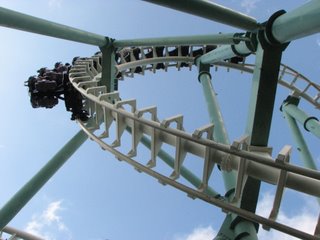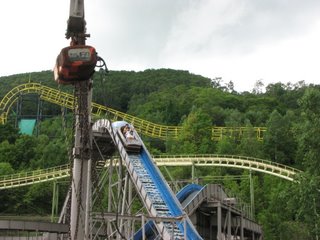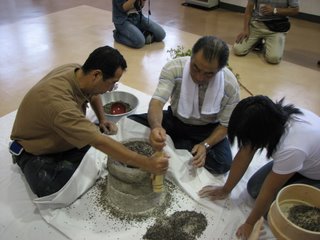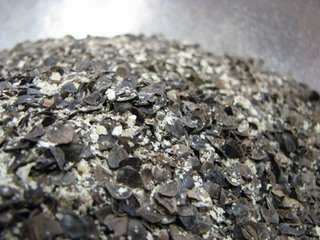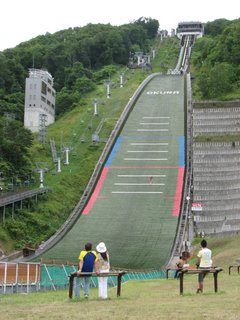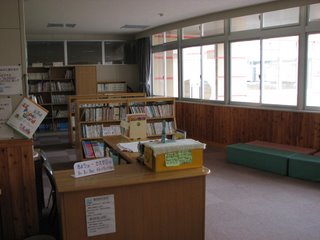Location: Tokyo
Date: 31th August 2006
Time: 1718, GMT+9
Magnitude: 4.8 (Light)
Epicentre: Tokyo Bay
Damage: Head concussion
It felt like ten godzillas marching on the field. The cupboard rattled, everything shook; the sun threatened to crash onto the ground. I dropped off from chair and cracked my head.
That was probably the strongest earthquake since I came here. Because it's the first one I've felt; I slept through the previous ones. It lasted for, like, 10 seconds, during which memories flashed through the mind the way it happens to people whose life is at stake.
But don't be silly. Of course I survived! Hallelujah! I'll just have to spend the next week being a crackpot with a head concussion.
Oh, got to go. The ambulance is here. Bye!
News report:
Bloomberg
Tokyo Shaken By Earthquake; No Damage Reported (Update1)
By Mari Murayama
Aug. 31 (Bloomberg) -- A magnitude 4.8 earthquake shook central Japan around Tokyo at 5:18 p.m. local time, NHK television news said. There were no immediate reports of damage or injuries from the quake, which was centered in Tokyo Bay.
Bullet train service was suspended between Tokyo and Odawara, about 100 kilometers (62 miles) south of the capital, Nippon TV reported. Service resumed at 5:30 p.m., Central Japan Railway Co., which operates the line, said.
East Japan Railway Co., which operates commuter rail lines around Tokyo, said service is operating normally. Tokyo Metro said all subways lines are running. Tokyo's two main airports, Narita and Haneda, have resumed operations.
NHK said there is no danger of tsunami, powerful ocean waves caused by seismic activity.
Japan, one of the world's most earthquake-prone countries, is located in a zone where the Eurasian, Pacific, Philippine and North American tectonic plates meet and occasionally shift, causing quakes. Quakes of magnitude 5 and more can cause considerable damage.
Earthquakes less than 4.9 in magnitude are described as ``light'' by the U.S. Geological Survey, which tracks seismic activity worldwide.
Date: 31th August 2006
Time: 1718, GMT+9
Magnitude: 4.8 (Light)
Epicentre: Tokyo Bay
Damage: Head concussion
It felt like ten godzillas marching on the field. The cupboard rattled, everything shook; the sun threatened to crash onto the ground. I dropped off from chair and cracked my head.
That was probably the strongest earthquake since I came here. Because it's the first one I've felt; I slept through the previous ones. It lasted for, like, 10 seconds, during which memories flashed through the mind the way it happens to people whose life is at stake.
But don't be silly. Of course I survived! Hallelujah! I'll just have to spend the next week being a crackpot with a head concussion.
Oh, got to go. The ambulance is here. Bye!
News report:
Bloomberg
Tokyo Shaken By Earthquake; No Damage Reported (Update1)
By Mari Murayama
Aug. 31 (Bloomberg) -- A magnitude 4.8 earthquake shook central Japan around Tokyo at 5:18 p.m. local time, NHK television news said. There were no immediate reports of damage or injuries from the quake, which was centered in Tokyo Bay.
Bullet train service was suspended between Tokyo and Odawara, about 100 kilometers (62 miles) south of the capital, Nippon TV reported. Service resumed at 5:30 p.m., Central Japan Railway Co., which operates the line, said.
East Japan Railway Co., which operates commuter rail lines around Tokyo, said service is operating normally. Tokyo Metro said all subways lines are running. Tokyo's two main airports, Narita and Haneda, have resumed operations.
NHK said there is no danger of tsunami, powerful ocean waves caused by seismic activity.
Japan, one of the world's most earthquake-prone countries, is located in a zone where the Eurasian, Pacific, Philippine and North American tectonic plates meet and occasionally shift, causing quakes. Quakes of magnitude 5 and more can cause considerable damage.
Earthquakes less than 4.9 in magnitude are described as ``light'' by the U.S. Geological Survey, which tracks seismic activity worldwide.



